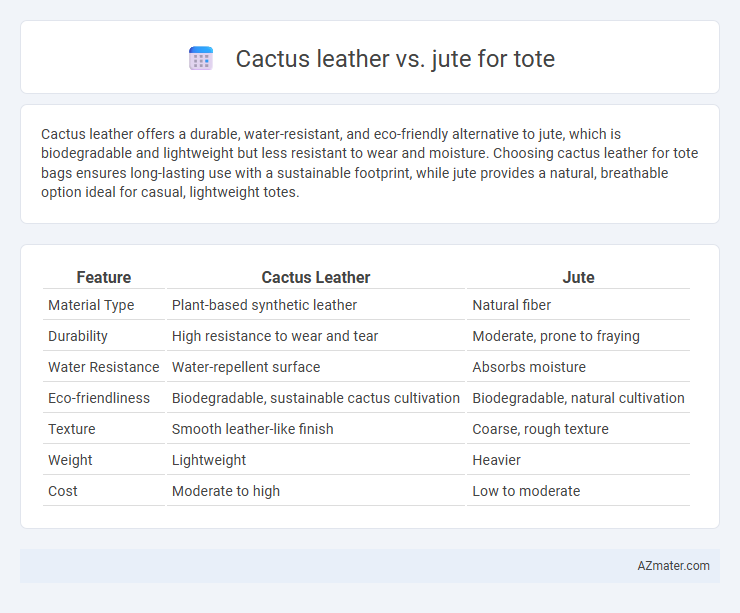Cactus leather offers a durable, water-resistant, and eco-friendly alternative to jute, which is biodegradable and lightweight but less resistant to wear and moisture. Choosing cactus leather for tote bags ensures long-lasting use with a sustainable footprint, while jute provides a natural, breathable option ideal for casual, lightweight totes.
Table of Comparison
| Feature | Cactus Leather | Jute |
|---|---|---|
| Material Type | Plant-based synthetic leather | Natural fiber |
| Durability | High resistance to wear and tear | Moderate, prone to fraying |
| Water Resistance | Water-repellent surface | Absorbs moisture |
| Eco-friendliness | Biodegradable, sustainable cactus cultivation | Biodegradable, natural cultivation |
| Texture | Smooth leather-like finish | Coarse, rough texture |
| Weight | Lightweight | Heavier |
| Cost | Moderate to high | Low to moderate |
Introduction to Sustainable Tote Materials
Cactus leather, derived from the mature leaves of the nopal cactus, offers a cruelty-free, biodegradable alternative to animal leather, making it ideal for sustainable tote production. Jute, a natural fiber harvested from the jute plant, is highly renewable, biodegradable, and known for its durability and breathability, widely used in eco-friendly tote designs. Both materials exemplify sustainable innovation by minimizing environmental impact through renewable sourcing and reduced chemical processing.
What is Cactus Leather?
Cactus leather is an innovative, sustainable material made from the mature leaves of the nopal cactus, processed into a leather-like fabric that is both biodegradable and cruelty-free. Unlike jute, which is a natural fiber derived from the jute plant, cactus leather offers a vegan alternative with durability and a soft, flexible texture ideal for tote bags. Its eco-friendly production consumes less water and emits fewer greenhouse gases, making cactus leather a superior green option for fashion accessories.
What is Jute?
Jute is a natural fiber derived from the bast of the jute plant, primarily used in eco-friendly textiles and packaging due to its durability and biodegradability. Often praised for its strong, coarse texture, jute is a renewable resource that requires minimal water and pesticides to cultivate, making it an environmentally sustainable choice for tote bags. In comparison to cactus leather, jute offers a more rustic, organic aesthetic but lacks the smooth, leather-like finish that cactus leather provides.
Environmental Impact: Cactus Leather vs. Jute
Cactus leather offers a sustainable alternative to traditional leather with a lower carbon footprint and reduced water usage, making it environmentally friendly. Jute, a natural fiber, is biodegradable and requires minimal pesticides and fertilizers, contributing to soil health and reduced pollution. Both materials have eco-friendly properties, but cactus leather's innovative manufacturing process reduces plastic waste, while jute's rapid biodegradability supports circular economy practices.
Durability and Longevity Comparison
Cactus leather offers superior durability and longevity compared to jute, as it is resistant to wear, water, and cracking, making it ideal for everyday use in tote bags. Jute, while eco-friendly with good tensile strength, tends to degrade faster due to its natural fibers being more susceptible to moisture and abrasion. The longevity of cactus leather totes extends up to several years with proper care, whereas jute totes typically show signs of wear within months to a year under regular use.
Aesthetic and Texture Differences
Cactus leather offers a smooth, supple texture with a sleek, modern aesthetic characterized by its fine grain and subtle sheen, making it ideal for sophisticated tote designs. Jute features a coarse, fibrous texture that emphasizes a rustic, natural look, often appealing in eco-friendly, casual totes. The visual contrast between cactus leather's polished finish and jute's organic roughness highlights their distinct aesthetic and tactile qualities.
Cost and Accessibility of Both Materials
Cactus leather offers a higher cost due to its sustainable production process and limited availability compared to jute, which is widely cultivated and inexpensive. Jute's affordability and abundant supply make it a popular choice for tote bags, whereas cactus leather remains a premium material favored for its eco-friendly appeal. Accessibility to jute is global and well-established, while cactus leather sourcing is currently limited to specific regions like Mexico, affecting its price and availability.
Maintenance and Care Requirements
Cactus leather requires minimal maintenance, often needing just a wipe with a damp cloth to remove dirt, making it highly durable and resistant to water and stains for tote bags. Jute, a natural fiber, demands more careful handling as it can absorb moisture easily, leading to potential mold or mildew if not kept dry and requires gentle cleaning with mild soap and water to maintain its strength and texture. Choosing cactus leather over jute for tote bags offers longer-lasting durability with less frequent care, ideal for everyday use in varied weather conditions.
Vegan & Ethical Considerations
Cactus leather offers a sustainable and cruelty-free alternative to traditional animal leather, derived from mature cactus leaves with minimal water usage and zero toxic chemicals, making it highly ethical for vegan consumers. Jute, a natural fiber harvested from the Corchorus plant, also supports eco-friendly practices due to its biodegradable nature and low environmental impact during cultivation. Both materials promote ethical fashion, but cactus leather stands out for its innovative use in vegan accessories, combining durability with a reduced carbon footprint compared to jute tote bags.
Best Choice for Eco-Friendly Totes
Cactus leather outperforms jute for eco-friendly totes due to its sustainable production process, which uses significantly less water and no pesticides compared to traditional plant fibers. The durability and soft texture of cactus leather offer a premium feel while maintaining environmental responsibility. Jute, though biodegradable and renewable, typically requires more land and water resources, making cactus leather the superior choice for sustainable tote bags.

Infographic: Cactus leather vs Jute for Tote
 azmater.com
azmater.com